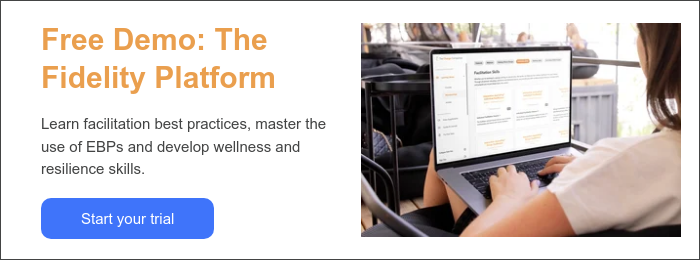Trauma-informed practices for group facilitation

Practicing trauma-informed care is essential across mental health care specialties, including justice services, SUD treatment and youth services. It can be helpful to remember that trauma exists across age, gender, race and socioeconomic status. Because of the prevalence of trauma, it makes sense to err on the side of universal sensitivity. Implementing trauma-informed, patient-centered care in group counseling sessions helps ensure positive participant outcomes.
What is Trauma?
Trauma occurs when a person is exposed to events that threaten their safety or the safety of someone close to them. These events may be physical, emotional or psychological. They may be related to patterns of overwhelming events or a single, dramatic incident.
Many trauma survivors are stuck in a stress response mode – the fight-or-flight instinct that brains and bodies use to protect them in unsafe situations. Even when the traumatic event is no longer a part of their lives, specific signals can trigger survivors’ trauma and lead to unhealthy coping behaviors. These behaviors may include self-harm, bullying or threatening others, becoming withdrawn, engaging in relational aggression, using food as a coping mechanism, using substances, manipulating others, damaging others’ property and other unhealthy behaviors.
Creating a Safe Program
Many components of Interactive Journaling® curricula already serve to reduce trauma responses and increase physical, psychological and emotional safety among participants. These practices include:
- Emphasizing CBT as a means to healing and challenging unhealthy thinking patterns
- Celebrating participant strengths and accomplishments in everyday interactions
- Using strength-based language in groups and one-to-one conversations
- Establishing program rules and agreements with the input and assistance of participants
- Introducing positive coping strategies and other skills that set participants up for success
- Building the practice of journaling into the program
- Directly addressing safety and respect as core program components
When these and other evidence-based, trauma-informed practices are part of a program culture, a sense of safety increases and staff burnout rates go down.
Trauma-informed Approaches in Program Facilitation
Part of a trauma-informed approach is eliminating the fallacy that a participant must have a cathartic experience around their trauma to heal and move forward. For this reason, when a participant is sharing a potentially graphic or triggering experience:
DON’T
- Encourage further details with questions like, “And then what happened?”
- Allow other participants to ask probing follow-up questions to the experience being shared.
- Abruptly change the topic or move on without acknowledging the reporting participant.
- Intentionally lead participants to the expression of intense emotions.
- Take conversations about trauma beyond your clinical training.
The following are strategies for appropriately responding to different trauma-related situations in group environments:
DO
- Find ways to redirect the conversation away from the experience to the reporting participant’s strengths, resilience, skills and lessons learned.
If a participant is self-disclosing a traumatic experience in too much detail, consider saying something like, “Out of respect for your privacy and the guidelines of our program, let’s take a step back from the story and talk about your [resilience, strengths, healthy coping skills] instead.”
If intense emotions arise as a result of a participant sharing a difficult experience with the group, redirect from the experience and explore supportive strategies instead. You might say, “There are some really strong emotions in the room right now. How can we support each other to manage these emotions in a healthy way?” In this way, other participants can share healthy coping skills that have helped them work through their own difficult experiences.
- Respectfully hand the conversation to others when another participant is dominating the conversation.
Rather than suggesting that the participant is taking others’ valuable time, frame your remarks as an opportunity for the participant to take a break from the difficult work of sharing. For example, “Let’s give Joe a break for a moment and have Ana share her thoughts.”
- Help people feel listened to and understood.
Acceptance and understanding are powerful, especially when someone is troubled by shame and vulnerability. Active listening skills allow you to show empathic understanding and help meet a person’s desire to be accepted. As Carl Rogers wrote, “If a person is understood, he or she belongs.”
Examples of active listening that convey deep understanding are:
“As you describe this, I can’t help but think how [difficult, frustrating, frightening, shaming] that was for you at the time. And maybe those are feelings that still come up for you.”
“You were trying really hard to make that [relationship, job, program] work – it must have been very important to you.”
“As you tell the group about that time in your life, you look a little [sad, frightened, shut down]. Is it hard to talk about?”
“That seems like a major hurt – something that could cause [sadness, worry, anxiety, fearful behaviors, shameful feelings] for a long time.”
Learning More
As you continue to learn about evidence-based, trauma-informed approaches, you will be better prepared to address sensitive issues as they come up. Additionally, watch for cues that may indicate a participant would benefit from trauma-specific programming.
Learn how to practice and implement trauma sensitive mindfulness →
More tips on group facilitation and managing group dynamics →

